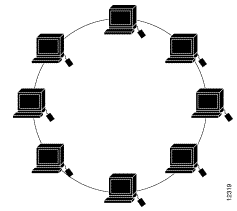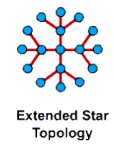Learn about local area network - LAN (Part I)
What is LAN?
Local Area Network (LAN) is a high-speed communication system designed to connect computers and other data processing devices to work together in a small geographic area like one. floor of the building, or in a building . Some LANs can connect together in a work area. LANs become popular because it allows users (users) to share important resources such as color printers, CD-ROM drives, application software and other necessary information. Before developing LAN technology the computers are independent of each other, limited by the number of utility programs, after connecting to the network it is clear that their efficiency is multiplied. To take advantage of all the advantages of LAN, people have connected separate LANs to the wide area network (WAN).
Topology of LAN
The network topology is a spatial geometrical structure that is essentially a layout of the network as well as a way to connect them. Commonly, there are three types of structures: Star Topology, Ring Topology and Linear Bus Topology. In addition to the three types of configurations above, there are some other variants of these three types such as tree network, star-ring network, mixed network, etc.
Star topology
Star-shaped networks include a center and information nodes. Information nodes are terminal stations, computers and other network devices. The center of the network coordinates all activities in the network with the basic functions:
- Identify pairs of addresses to send and receive permission to occupy information lines and communicate with each other.
- Allow monitoring and mishandling in the process of information exchange.
- Notify the status of the network .

Advantages of a star network:
- Operating on a parallel connection principle, if there is a broken device in an information node, the network will still function normally.
- Simple network structure and stable control algorithms.
- The network can be expanded or shrunk according to user requirements.
Disadvantages of star-shaped networks:
- Network scalability completely depends on the capabilities of the center. When the center has a problem, the whole network stops working.
- The network requires independent connection of each device separately at information nodes to the center. The distance from the machine to the center is very limited (100m).
In general, the form network allows connecting computers to a centralized unit (HUB) with twisted cable, this solution allows to directly connect the computer to the HUB without going through the BUS axis, avoiding the causing factors Network stall. Recently, along with the development of switching hubs, this model has become increasingly popular and accounts for the majority of newly installed networks.
Linear network (Bus Topology)
According to the road corridor layout as shown, the server (host) as well as all other computers (workstations) or nodes (nodes) are connected together on a main cable line to convey signal. All nodes use this same main cable. The two ends of the cable are covered by a device called a terminator. Signals and packets when moving up or down in cables carry the address of the destination. This type of network uses the least cable, easy to install. However, there are also disadvantages that there will be traffic congestion when moving data with large traffic and when there is a failure in some section it is difficult to detect, a stop on the line to repair will stop the whole system.

Ring Topology (Ring Topology)
This network, arranged in a circular form, is designed to be a closed loop, the signal running around in a certain direction. The buttons that communicate each other at a time are only one button. The transmitted data must be accompanied by the specific address of each receiving station. The ring network has the advantage of being able to extend far away, the total line needed is less than the two. The downside is that the line is not closed, if it is disconnected somewhere, the whole system is also stopped.

Mesh topology - Mesh topology
The slender structure is used in high-importance networks that cannot be deactivated, such as in nuclear power plants or security and defense networks. In this type of network, each computer is connected to the rest of the computers. This is also the structure of the Internet.

Star network expanded
This network configuration combines star-shaped networks by connecting HUBs or Switches. The advantage of this network configuration is that it can extend the distance as well as the size of the star network.

Hierachical topology - Hierachical topology
This network is similar to an extended star network, but instead of connecting switches / hubs together, the system connects to a computer that performs network traffic monitoring.
See next section: Local area network - LAN: Ethernet - Part II
Explore more:
- How to find the IP address of another computer on the LAN
- Use static IP address in network
- What is VLAN? How to configure a VLAN on Cisco Switch?
You should read it
- Learn about Home Area Network (HAN)
- How to Set Up a Local Area Network (LAN)
- Wide area network WAN - Next part
- GAN (Global Area Network) price, marketcap, chart, and fundamentals info
- Learn about Personal Area Network (PAN)
- How to scan local area network with Terminal on macOS
- Basic information about network equipment
- Learn about basic WLAN devices
May be interested
- Learn about basic WLAN devices
 wireless network (wireless local area network) is the preferred wireless network system by providing high-speed data transmission, with long distances without worrying about wires, cables ...
wireless network (wireless local area network) is the preferred wireless network system by providing high-speed data transmission, with long distances without worrying about wires, cables ... - GAN (Global Area Network) price, marketcap, chart, and fundamentals info
 global area network (gan) network refers to a network consisting of many networks connected together covering an unlimited geographical area. this term is synonymous with the internet and is considered a global network.
global area network (gan) network refers to a network consisting of many networks connected together covering an unlimited geographical area. this term is synonymous with the internet and is considered a global network. - Local area network - LAN: Devices - Part III
 hub - also called multiport repeater, it functions exactly like the repeater but has multiple ports to connect to other devices. the common hub has 4,8,12 and 4 ports and is the center of the star network. there are usually the following hub types
hub - also called multiport repeater, it functions exactly like the repeater but has multiple ports to connect to other devices. the common hub has 4,8,12 and 4 ports and is the center of the star network. there are usually the following hub types - How to Configure Computers on a Local Network
 in this article, tipsmake will guide you how to install a lan (local area network) to connect multiple windows computers.
in this article, tipsmake will guide you how to install a lan (local area network) to connect multiple windows computers. - Local area network - LAN: Introduce WAN network - Part V
 in this article we will introduce different protocols and technologies used in wide area networks - wan. topics include point-to-point connection, switching - circuit switching, packet switching - packet switching, circuit o, and devices used in wan
in this article we will introduce different protocols and technologies used in wide area networks - wan. topics include point-to-point connection, switching - circuit switching, packet switching - packet switching, circuit o, and devices used in wan - Learn about Personal Area Network (PAN)
 a personal area network (pan) is a network that connects computers / devices within an individual's range. because pan provides network coverage in a radius of around a person, usually around 10 meters (33 feet).
a personal area network (pan) is a network that connects computers / devices within an individual's range. because pan provides network coverage in a radius of around a person, usually around 10 meters (33 feet). - Learn about 5G network, future mobile platform
 in essence, the 5g network is still developed based on 4g platform but at a higher level. 5g network will support las-cdma (large area synchronized code division multiple access), uwb (ultra wideband), network-lmds (local multipoint distribution service), ipv6 and bdma (beam division multiple access).
in essence, the 5g network is still developed based on 4g platform but at a higher level. 5g network will support las-cdma (large area synchronized code division multiple access), uwb (ultra wideband), network-lmds (local multipoint distribution service), ipv6 and bdma (beam division multiple access). - Instructions for installing Mail Offline on MDaemon program.
 mail offline is a system that operates based on the pre-installed local area network (local area network) model. in this network you do not need to have a dedicated server, but you only need to specify a machine with relative configuration to be the server (mail server), and the capacity of the hard disk must be enough to store the message , hard disk capacity must match the number of mail and the number of employees of your company
mail offline is a system that operates based on the pre-installed local area network (local area network) model. in this network you do not need to have a dedicated server, but you only need to specify a machine with relative configuration to be the server (mail server), and the capacity of the hard disk must be enough to store the message , hard disk capacity must match the number of mail and the number of employees of your company - What is Area 51? What happens in Area 51?
 area 51 is associated with stories of ufos and the possibility of alien technology testing. so what is area 51? what is going on inside area 51?
area 51 is associated with stories of ufos and the possibility of alien technology testing. so what is area 51? what is going on inside area 51? - Backup from this computer to another computer
 wncdude asked on networking forum about backing up this computer to another computer via local network.
wncdude asked on networking forum about backing up this computer to another computer via local network.










 How do Private Network and Public Network on Windows differ?
How do Private Network and Public Network on Windows differ? How to connect the network between two laptops using a network cable
How to connect the network between two laptops using a network cable How to use Idea VPN fake IP on Windows
How to use Idea VPN fake IP on Windows How to use X-VPN to surf anonymously on Windows
How to use X-VPN to surf anonymously on Windows About IPv6 address
About IPv6 address IP Camera slows down network? This is how to fix it
IP Camera slows down network? This is how to fix it